
WASHINGTON (PTI): Humans have always fantasised of "little green men" from Mars, and scientists have now come up with a new way to search for traces of alien life on the Red Planet.
Visits to Mars by unmanned probes from NASA and the European Space Agency have found evidence that a prime condition for life once may have existed: water.
"There has been a tremendous amount of very exciting findings this year that Mars once contained actively flowing, low-saline, near-neutral-pH water - pretty much the type of water where you find life on Earth today," said Alison Olcott Marshall, assistant professor of geology at the University of Kansas.
"This has made people think that it's possible that life could have existed on Mars, although most researchers agree it's unlikely to exist today - at least on the surface - as conditions on the surface of Mars are incredibly harsh," said Marshall.
Marshall is working with her colleague, Craig Marshall, associate professor of geology at KU, to improve the way scientists detect condensed aromatic carbon, thought to be a chemical signature of astrobiology.
"If we're going to identify life on Mars, it will likely be the fossil remnants of the chemicals once synthesised by life, and we hope our research helps strengthen the ability to evaluate the evidence collected on Mars," Craig said.
If traces of ancient biology are detected in Mars, the KU researchers want to make sure the evidence is more conclusive.
According to a recent paper in the journal Philosophical Transactions of the Royal Society, by itself Raman spectroscopy is able to screen for carbonaceous material, but it can't determine its source - thus the technology needs to be supplemented in order to determine if life exists on Mars.
"Raman spectroscopy works by impinging a laser on a sample so the molecules within that sample vibrate at diagnostic frequencies," Craig said.
"Measuring those frequencies allows the identification of inorganic and organic materials. It's insufficient because however the carbonaceous material is made, it will be the same chemically and structurally, and thus Raman spectroscopy cannot determine the origin," said Craig.
Researchers call for the use of gas chromatography/mass spectroscopy to supplement Raman spectroscopy and develop more conclusive evidence of ancient extraterrestrial life.
 Previous Article
Previous Article Next Article
Next Article













The Indian Air Force, in its flight trials evaluation report submitted before the Defence Ministry l..
view articleAn insight into the Medium Multi-Role Combat Aircraft competition...
view articleSky enthusiasts can now spot the International Space Station (ISS) commanded by Indian-American astr..
view article